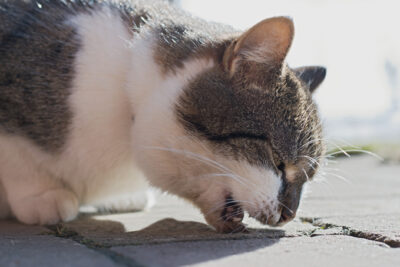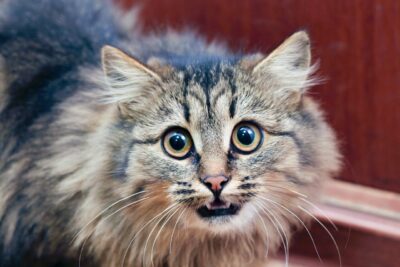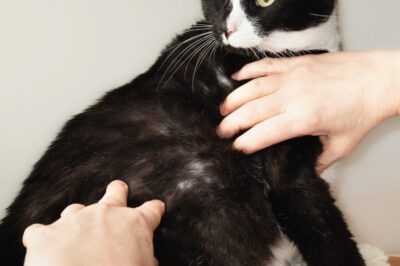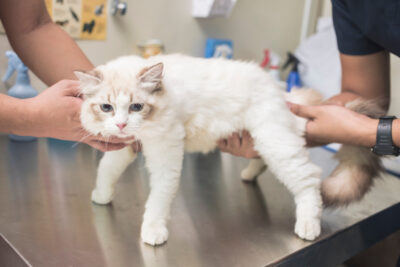Respiratory Infections in Cats
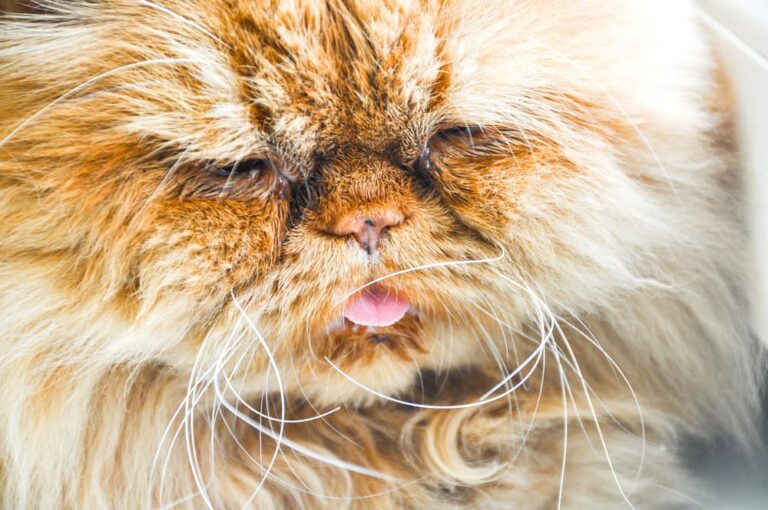
Overview
- Most cats will experience a respiratory infection in their lifetime.
- Cats can have upper or lower respiratory infections. Lower respiratory infections are more serious.
- Viruses, bacteria, fungi, and parasites can all cause respiratory infections.
- Treatment will depend on the cause. Lower respiratory infections require more extensive treatment.
- Regular veterinary care and the FVRCP vaccine can help prevent respiratory infections in cats.
Sponsored by CareCredit
The vast majority of our cats will experience a respiratory infection in their lifetimes. While many of these infections are not that serious, some are life-threatening and need treatment right away.
Read more to understand this complex condition and what symptoms to watch for.
What Are Cat Respiratory Infections?
The respiratory system in cats goes from the nose all the way to the lungs—including the nasal cavity (chamber of the nose), pharynx (throat), larynx (voice box), trachea (windpipe), and lungs. Inside the lungs are passageways for air called bronchi that get smaller and lead to bronchioles.
The lining of the whole respiratory system contains cells that secrete mucus, or the thick gooey material you are familiar with from blowing your nose or coughing. When an infection is in the respiratory system of cats, the cells lining the system become inflamed and produce a larger amount of mucus.
Common Types of Cat Respiratory Infections
There are generally two types of respiratory infections in cats: upper and lower respiratory infections.
Upper respiratory infections affect the nasal cavity, throat, and voice box.
Lower respiratory infections affect the windpipe and lungs, including the bronchi. This can be called bronchitis or pneumonia.
Some cats develop an infection that affects both upper and lower respiratory systems at the same time.
Infections can be caused by a variety of pathogens including:
- Viruses
- Bacteria
- Fungi
- Parasites
Symptoms of Cat Respiratory Infections

Upper respiratory infections are much more common in cats, and while they can make our kitties feel ill, they are not as serious as lower respiratory infections. Oftentimes symptoms overlap, so it can be difficult to distinguish between upper and lower respiratory infection on symptoms alone.
Generally speaking, symptoms for upper and lower respiratory infections are listed below.
Symptoms of Cat Upper Respiratory Infections
- Sneezing
- Nasal congestion (stuffiness, so that you can hear your cat breathing)
- Runny eyes or nose (can be watery or yellow-green discharge)
- Change in voice (the meow sounds different or hushed)
- Swallowing more dramatically
- Mild to moderate decrease in activity or appetite
Symptoms of Cat Lower Respiratory Infections
- Cough
- Increased effort to breathe, noted by dramatic chest movements
- Wheeze when breathing out
- Lack of appetite
- Moderate to severe decrease in activity
- Respiratory distress – panting (breathing loudly with mouth open), belly and chest moving dramatically to breathe
If your cat shows any symptoms of a respiratory infection, prompt veterinary care is essential. However, unexpected trips to the vet can throw a wrench into your budget. If you’re worried about unexpected pet health costs, options like pet insurance or a health and pet care credit card can help. You can use a CareCredit credit card to pay for unplanned pet health expenses, so you never have to delay important treatment.*
Causes of Respiratory Infections in Cats

Most cat respiratory infections are caused by viruses. Viruses are contagious from cat to cat and are usually spread by sneezing and from discharge of the nose or eyes. Even if the cats do not come into contact with one another, if a sick cat sneezes on an object and another cat interacts with the object, the virus could be spread.
The most common viruses include:
- Feline herpesvirus-1 (also known as feline viral rhinotracheitis)
- Calicivirus
Bacteria is commonly found in cats with respiratory infections, but oftentimes it is not the primary cause. A virus or other pathogen usually causes the infection first. Kittens are more likely to have infections caused by bacteria because their immune systems are not fully mature.
The most common bacteria that cause respiratory infections in cats include:
- Mycoplasma spp.
- Bordetella bronchiseptica
- Chlamydophila felis
Fungi can also cause respiratory infections, but it is not as common of a cause as viral or bacterial infections. Fungi infections are obtained from the general environment—in dirt or pools of water outside, for instance.
The most common fungi include:
- Cryptococcus
- Blastomyces
- Aspergillus
- Histoplasma
Parasitic infections are also uncommon, but important causes of respiratory infections. Most parasitic infections come from eating prey species such as birds or rodents.
The most common parasites include:
- Lungworms (Aelurostrongylus or Capillaria)
- Cuterebra botfly larva
Cats that have a compromised immune system, or lack of protection in the body against infections, are more frequently affected by respiratory infections. Reasons a cat may be more susceptible include:
- Young age (kittens)
- Old age (senior cats)
- Chronic medical condition of the respiratory system (such as asthma)
- Chronic medical condition of other systems (anything from chronic kidney disease to feline leukemia virus)
- Inadequate care, such as poor diet or lack of vaccinations/veterinary care
- Crowding with other cats
Diagnosing Your Cat
An upper respiratory infection is most commonly diagnosed on physical examination by a veterinarian. Because symptoms overlap with lower respiratory infections, your veterinarian may recommend X-rays (radiographs) to confirm the infection is not in the lower respiratory tract.
To determine the cause of the upper respiratory infection, your veterinarian may take a cotton-tipped swab and put it inside your cat’s nose. Occasionally, when infection is severe, your veterinarian may take a small biopsy from the inside of the nose which requires anesthesia and a minor surgery. Some specialized blood tests can be used to try and look for certain fungal infections.
A lower respiratory infection is most commonly diagnosed on X-rays at a veterinary hospital. Physical examination by a veterinarian can help determine the severity of the infection. To determine the cause of infection, your veterinarian may recommend what is called a wash. It is a procedure under anesthesia when sterile fluid is flushed into the lungs for a very short amount of time then suctioned gently back out. Specialized blood tests may be needed as well.
Treatment for Cat Respiratory Infections

There are various treatments for each specific cause of respiratory infections in cats, such as antibiotics for bacteria and antifungals for fungi. There is rarely treatment for viral infections available.
Treatment is most dependent on the severity of symptoms and if it involves the upper or lower respiratory tract. Many cats with respiratory infections do not eat well and may be dehydrated, so treatment must ensure kitty is getting enough fluids and nutrients.
Severe lower respiratory infections may require hospitalization and additional oxygen that will help your cat breathe easier. If you notice symptoms of a lower respiratory infection in your cat, he should be brought to the veterinarian immediately.
Medications for Cat Respiratory Infections
Depending on the cause of your cat’s respiratory infection, your veterinarian may recommend one of the following medications:
Antivirals: These come in pill form and are used against viral infections. An example includes famciclovir.
Antibiotics: These come in pills, liquids, or injections. They are used against bacterial infections and may help a cat recover from a virus more quickly. Examples include doxycycline, enrofloxacin, azithromycin, amoxicillin-clavulanic acid.
Antifungals: These medications are available in pill or liquid form and are used against fungi infections. Examples include itraconazole, fluconazole.
Antihelminthics: Used to treat parasitic infections, this medication comes in a liquid or powder form, or is available as an injection. Examples include fenbendazole, ivermectin.
Home Remedies for Cat Respiratory Infections
If your cat has symptoms of a lower respiratory infection, there are no home remedies that can help, and it could be a life-threatening emergency. If you see any signs of a lower respiratory infection, take your cat to the veterinarian and do not attempt to treat your cat’s symptoms at home.
If you cat has an upper respiratory infection, here are a few home remedies to help with the symptoms:
Keep your cat’s face clean. Remove debris or discharge from your cat’s face to keep him comfortable.
Use saline drops in the nose. Saline can be purchased at any pharmacy and it decreases nasal congestion. Ask your veterinarian before using saline drops at home.
Provide steam showers. Place your cat in a small bathroom and turn the shower water on hot to create a lot of steam. This decreases nasal congestion
Warm up tasty food. Many cats with respiratory infections do not eat well because they cannot smell the food. Purchase multiple kinds of cat food, warm it up, and offer it to your feline to entice eating.
General Cost to Treat a Cat Respiratory Infection
An upper respiratory infection can cost as little as $100 to treat by having your kitty examined by a veterinarian and given medication. If your cat is feeling ill and requires a lot of treatments such as fluids to rehydrate, an upper respiratory infection can cost $300 or more. With uncommon causes such as fungal causes, the medication is expensive and given for a long time, increasing your total spending to $500 or more.
A lower respiratory infection costs more, since it involves the lungs, impacts breathing, and can be a life-threatening condition. Hospitalizing your cat, performing tests, and keeping your kitty in an oxygen chamber can cost $1,000 or more depending on your geographic area and the severity of your cat’s infection. Occasionally, if the infection is mild or caught very early, you may be spending closer to $500.
If the prospect of paying these unexpected costs is daunting, a CareCredit credit card could be a helpful resource. It allows you to pay for veterinary care over time with flexible financing options, so you can focus on your cat’s recovery instead of mounting vet bills.*
How to Prevent Your Cat From Getting an Infection

Prevention of respiratory infections mostly involves providing your cat a healthy lifestyle to support his immune system. Supporting your cat’s immune system means providing routine veterinary care, decreasing stress, and providing a quality diet at home.
Routine veterinary care (at least every year) is very important for preventing disease. One of the most important prevention methods is vaccination with the FVRCP vaccine, also known as distemper vaccine in cats. The “FVR” portion of the vaccine stands for feline herpes. The “C” portion of the vaccine stands for calicivirus. The vaccine should be given yearly to start, followed by every three years afterward. It is given either as an injection under the skin or droplets into the nose. Another type of prevention is giving monthly preventative against common parasites and yearly deworming.
Avoid allowing your cat to interact with other cats of unknown health status, as some of the infections that cause respiratory infections are contagious.
*Subject to credit approval. See carecredit.com for details.
This information is shared solely for your convenience. Neither Synchrony nor any of its affiliates, including CareCredit, make any representations or warranties regarding the products described, and no endorsement is implied. You are urged to consult with your individual veterinarian with respect to any professional advice presented.

